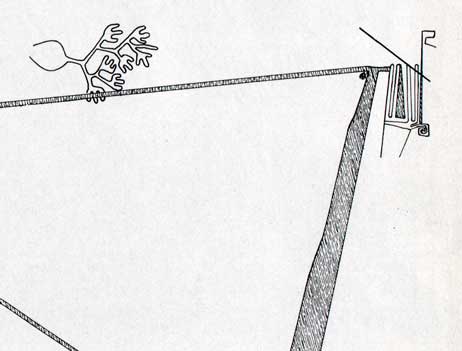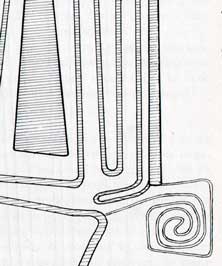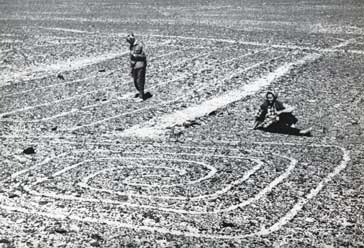|
The drawing below shows the whole scheme on this part of the Nazca Plain. On this scale the drawings cover an area of thousands of square feet. The dryness of the Nazca desert plain, which rarely sees any rainfall, is what preserves these images.
They were first noticed in the early 1920’s by airline pilots, and only re-discovered properly in the late 1940’s by Maria Reiche, from whose out-of-print 1977 book, “Mystery on the Desert” these images are borrowed to illustrate her work and document her achievements.

Copyright © 1949, Maria Reiche
She lived on the Nazca plain for many years trying to protect them from roads and the many other encroachments of human activity.
She painstakingly recorded the many complex schemes of apparently chaotic geometric patterns, and about the drawing to the left, and of other similar schemes, she had this to say:
“As an example of such a formative element we take a shape, which in Nazca terminology could be named ‘the whip’. It consists of a long triangle or trapezoid from which at it’s shorter end a line goes out running back again beside it.
An oscillating line, a spiral and a triangle at the upper right of a huge geometric drawing appear tiny beside it. Zigzag and oscillating lines can be found isolated or running beside or across triangles and quadrangles.”
There are literally hundreds of geometric patterns such as these all across the Nazca Plain area. Some appear at first glance to stand alone, while others are such a criss-crossed jumble it is hard to make out which lines belong to which scheme.
Below is part of the same drawing focused onto the square spiral shape seen in the top right hand corner of the larger scheme shown in the drawing above, but on a much larger scale.
As you get closer to the ground the intricate work becomes more apparent. There is much speculation as to how the architects of these geoglyphs actually managed to draw them, many being continuous lines running parallel to some and across others.

Copyright © 1949, Maria Reiche
As can be seen from this enlargement above, and the ground-level photograph below, the square spiral shape is continuous, starting and ending on much wider lines that are part of a larger scheme.
Thanks to the many years of dedicated work by Maria Reiche some sense is now beginning to be made of the underlying patterns, with similiar shapes being repeated over numerous large and small inter-linked schemes that are often many miles apart.
“All over the thirty miles and more of desert where ground drawings can be found, these show always the same basic forms. The same kind of quadrangles, triangles, zigzag and oscillating lines on large and small scales, the same starlike centres can be found everywhere, on vast plains, narrow plateaus between gorges and on islands of even ground amidst a maze of dry riverbeds.”
The photograph below shows the same square spiral image and its size relative to a human. This sequence of the two diagrams above, and the photograph below, will hopefully give an idea of the immense scale of the geoglyphs on the Nazca Plain of Peru.
It is generally believed by archaeologists who have examined them that they were built over a period of several hundred years beginning around 600 BC, and while this may explain why so many of the figures overlap each other, Maria Reiche was in no doubt that all the figures were definitely inter-connected.

Copyright © 1949, Maria Reiche
“They are one single creation and are, together with the animal figures, quantitatively and qualitatively the most outstanding of all works by ancient Peruvians.
One has to consider the countless tons of stones which were removed from the geometric surfaces, the care that had to be taken to make lines and borders absolutely straight and to give them the exact directions which they were intended to have.
To that must be added the difficulties which lay in the drawing of the figures with their beautiful and regular curves, which could only have been produced in these giant sizes if every piece, being part of a circle, had a radius and a centre whose length and exact position were carefully laid out.”
One theory is that the lines, triangles and the many different trapezoid shapes may be orientated to astronomical phenomena visible on the horizons in the directions to which they point.
This line of thought is nothing new though. Maria Reiche tells that in the 1940’s Dr. Paul Kosok had noticed astronomical alignments to both the Summer Solstice sunrise and sunset.
Newer theories speculate that the animal drawings represent the figures of the constellations of stars in the Southern Hemisphere, as visualised by the ancient peoples of the Nazca plain.
all quotes on these tribute pages are from
“Mystery on the Desert”
by Maria Reiche
Share This Page
With Your Favourite Social Networks
 | |
 | |
 | |
 | |
 | |
 | |
 | |
 | |
 | |
 | |
 | |
 | |
 | |

Tweet This Page

|